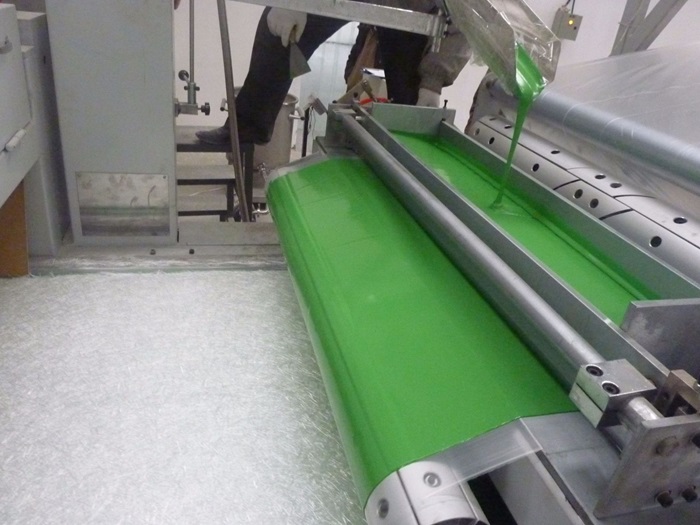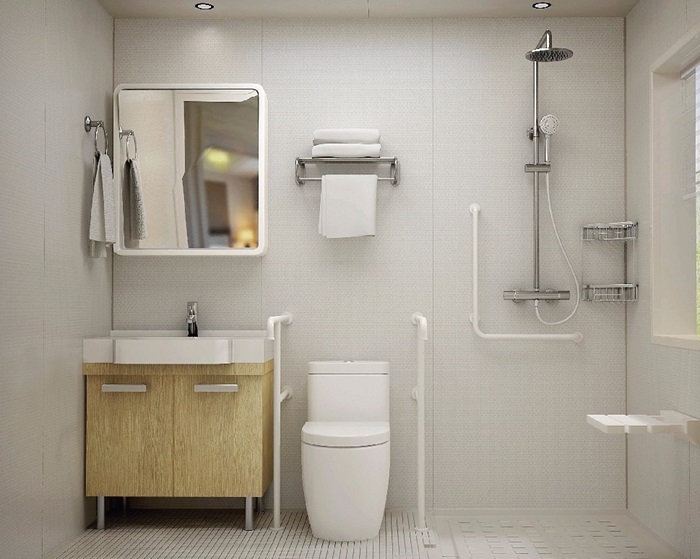SMC is a molding compound used in the dry-process manufacturing of unsaturated polyester fiberglass products. The material is highly resistant to heat, insulation, and corrosion and is widely used in transportation vehicles, construction, electronics/electrical, and other industries.
Composition of SMC sheets
The middle core material comprises short-cut fibers (or felt) fully impregnated with resin paste. The upper and lower surfaces are covered with polyethylene film. The resin paste contains ingredients such as unsaturated polyester resin, initiator, chemical thickener, low shrinkage additive, filler, release agent, colorant, etc.
Production process of SMC sheets
Special SMC sheet machines produce SMC sheets. Chopped raw yarn mats or glass fiber coarse fibers are laid on a PE film that is pre-evenly coated with resin paste and then covered with another layer of PE film coated with resin paste, forming a “sandwich” structure. The resin paste and glass fiber (or mat) are fully kneaded, collected into rolls, and subjected to necessary aging treatment when it passes through the impregnation zone. After the sheet is non-sticky, it can be cut into a certain size.
Characteristics of SMC materials
• High strength and lightweight: excellent mechanical properties and low density.
• Strong corrosion resistance: acid, alkali, and chemical corrosion resistant.
• Excellent electrical properties: strong insulation and arc resistance.
• Heat-resistant and flame-retardant: stable at high temperatures and fireproof.
• Good surface properties: smooth and flat, anti-aging.
• Strong design ability: good plasticity, suitable for complex structures.
• High production efficiency: short molding cycle.
• Environmental protection: less manufacturing waste and recyclable.
Application areas of SMC materials
1. Automotive industry:
SMC materials have gradually become the leader in the automotive industry due to their lightweight and high strength. On the one hand, using lightweight and high-strength materials can reduce cars’ energy consumption while driving. On the other hand, SMC materials are cheaper than traditional metal materials.
1) Suspension parts Front and rear bumpers, dashboards, etc.
2) Body and body parts: Body shell, hard shell roof, floor, door, radiator grille, front end plate, spoiler, luggage compartment cover, sunshade, fender, engine hood, headlight reflector.
3) Under-hood parts include air conditioner housing, air guide cover, intake duct cover, fan guide ring, heater cover, water tank parts, brake system parts, a battery bracket, engine sound insulation board, etc.
4) Interior decoration parts: interior panels, door handles, dashboard, steering rod parts, mirror frames, seats, etc.
5) Other electrical parts include pump covers and drive system parts like gear sound insulation boards.
Bumpers, roofs, front face parts, engine hoods, engine sound insulation panels, front and rear fenders, and other parts are the most important and have the largest output.
2. High-speed rail industry:
The strength, fatigue performance, lightweight, and processability of the materials used for the rapidly developing high-speed rail industry should be higher. Therefore, SMC materials are increasingly used in this field. They mainly include railway vehicle window frames, toilet components, seats, coffee table tops, carriage wall panels, roof panels, etc.
3. Construction industry
1) Water tank
2) Shower products. The main products include bathtubs, shower rooms, sinks, waterproof trays, toilets, dressing tables, etc.
3) Purification tanks
4) Building templates
5) Storage room components
4. In the electrical industry and communications industry
The application of SMC in the electrical industry and communications engineering mainly includes the following parts.
1) Electrical housing: including electrical switch boxes, electrical wiring boxes, instrument panel covers, etc.
2) Electrical components and motor parts, such as insulators, insulating operating tools, motor windshields, etc.
3) Electronic engineering applications, such as printed circuit boards of electronic machines, etc.
4) Communication equipment applications: telephone booths, wire and cable distribution boxes, etc.
5. Other applications
1) Seats
2) Containers
3) Pole jackets
4) Tool hammer handles and shovel handles
5) Catering utensils, such as vegetable sinks, microwave tableware, bowls, plates, and other food containers.
Post time: Jun-16-2022








